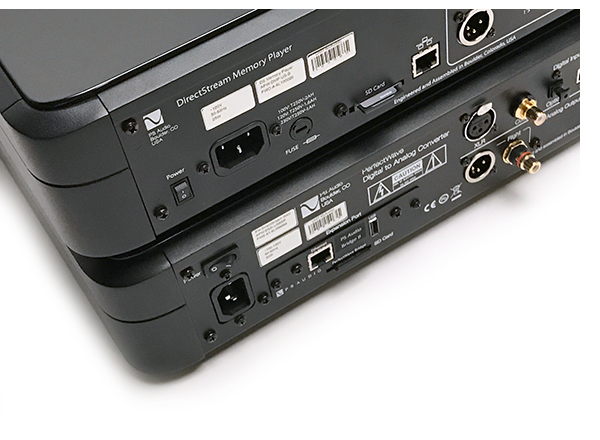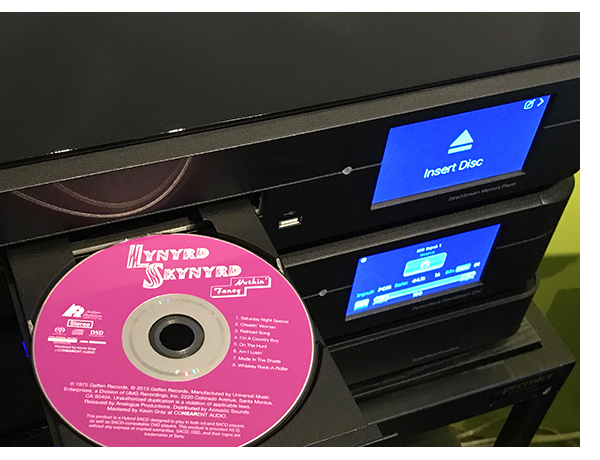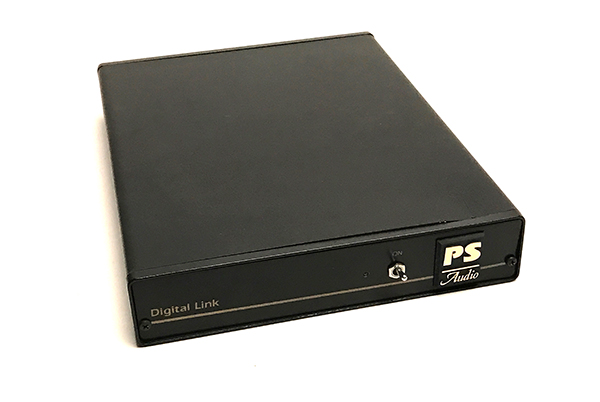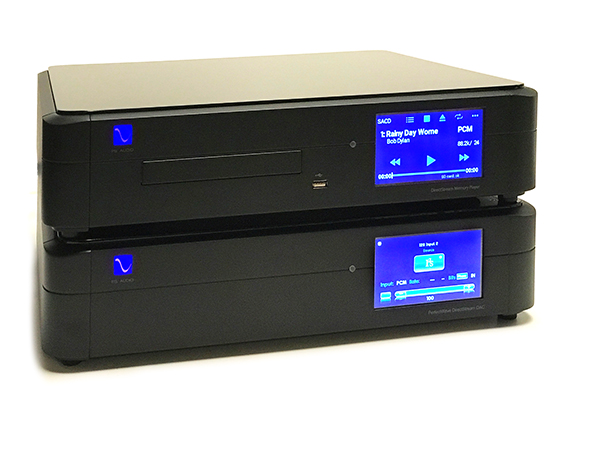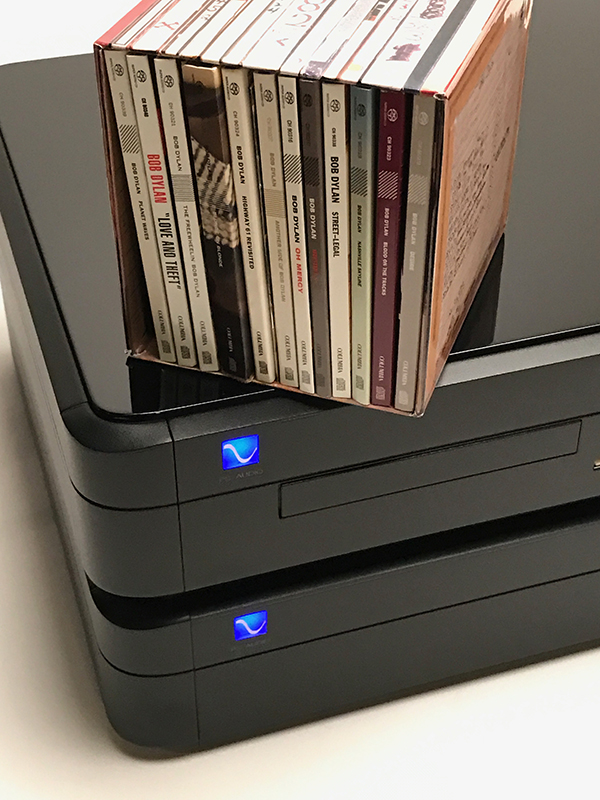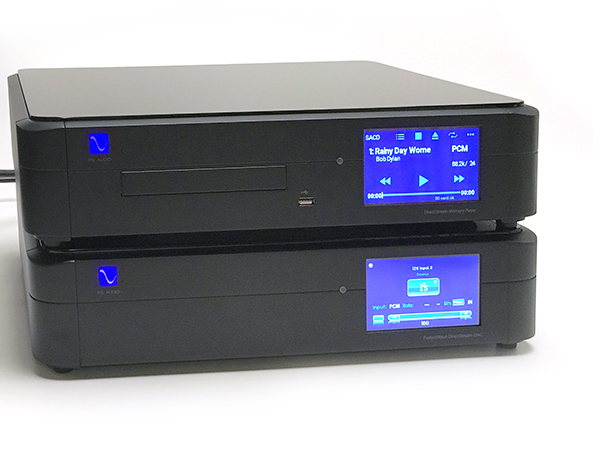 The second I pushed the play button on PS Audio’s DirectStream Memory Player, listening to my favorite Art of Noise SACD, it was instantly clear that this is an exciting product.
The second I pushed the play button on PS Audio’s DirectStream Memory Player, listening to my favorite Art of Noise SACD, it was instantly clear that this is an exciting product.
Dropping in a DVD Audio disc of The Doors’ LA Woman is equally thrilling, with buckets of low level resolution, the stuff that we all got excited about years before HD Tracks came on the scene. There’s some incredibly cool stuff going on at the extreme high end of digital, but it’s gonna cost you about as much as a new Z06 Corvette. Equally exciting things are happening at the entry level of digital too, but groundbreaking as some of it is, it doesn’t pass muster in a mega system. PS Audio’s new combo gives a major helping of cost no object digital for just under $12,000, and they even send someone to your door to unbox it. Now that’s impressive.
Crazy as it might sound, the $5,000 to $15,000 range is somewhat vacant. A few boxes come to mind, but they are mostly DACs. Simaudio’s 780D is exceptional at $15k, but it doesn’t play shiny discs. And some of us still want to play shiny discs; some of us have big collections of shiny discs. Even DVD-a shiny discs. If you are strictly a streaming audiophile these days, you don’t need the DMP – skip to the DAC section of this review. But if you’ve got the urge to spin physical media, read on. The DSMP is a revelation, and if you don’t need a disc spinner, this marvel will only set you back $5,999.
Much like my reference dCS, the DirectStream DAC does not rely on off the shelf DAC chips; instead it is controlled by FPGA (field programmable gate arrays) and all the upsampling, decoding and filter functions are software controlled, which will make this DAC a lot more future proof than one reliant on implementing the latest Sabre chip. Super impressive for just under six grand.
Don’t freak out, the DMP is based on an OPPO transport. But before you cry wolf, fraud, or “oh no, not another AYRE debacle,” chill out. The PS people are very forthright about the transport and PS’ Bill Leebens says candidly, “The basic drive mechanism is a Blu-ray unit sourced from Oppo. The mechanical element is all that remains: all video circuitry, which can add noise and distortion to the audio signal, has been removed. All control and processing of both digital and analog signals is done in circuitry designed and built by PS Audio.”
So, you aren’t paying $5,999 for a hot rodded Oppo. There are only so many sources remaining for a transport that can play everything, and even dCS only offers an SACD capable transport for their six-figure Vivaldi 2. The good news is that Oppo sells a lot of boxes, so you can be sure that replacement mechanisms will be readily available because let’s face it, everything that spins will fail at some point. I see this as a very good thing. It’s also worth mentioning here that both the DAC and the transport are hand built in PS Audio’s factory right here in Boulder, Colorado.
The Catch
To achieve full-blown SACD performance, where the DMP is grabbing the DSD bitstream directly from your SACD disks, you need the matching PS Audio DirectStream DAC, also priced at $5,999. We reviewed an early version of this DAC several years ago, and found it to be an excellent performer. The current version is more of the same, utilizing PS Audio’s I2S bus through HDMI. This allows the DAC to directly read the DSD stream. Because of the way the I2S keeps data and clock signals separate, it makes for a more lifelike musical rendition.
It’s common knowledge these days that jitter and timing errors are the major culprits behind digital discs sounding harsh, crunchy and un-musical. Great as the benefits of keeping things on the bus separate in the SACD/DSD realm, the effect is just as powerful when playing standard redbook CDs. And if you’re a lover of the shiny discs, chances are you have a ton of these.
Playing a notoriously lousy CD from my pile, The Eurythmics We Too Are One is nothing short of a revolution. It’s not like I haven’t heard CD’s sound this good before, I’ve had some of the world’s best digital players in my rack over the last ten years – I’ve never been married to analog. I’ve just never heard CD’s sound this good in a box this approachable. Does it blow my dCS Rossini DAC and clock out of the water? No, but the sound quality is damn close and my $40,000 dCS doesn’t play my SACDs. Am I going to put my Rossini up on Audiogon? Nope, but I’m seriously thinking of buying the PS Audio pair to sit right beside it on my rack. I like the shiny discs.
The DirectStream DAC by itself is equally exciting with digital files. This is a breakthrough product in terms of what it offers in musical truth for the price asked. The difference between good, really good, and great digital is the degree that it gets out of the way of the music. Quick test: if you find yourself thinking or saying “this sounds pretty good for digital,” said component has failed the awesomeness test. The DMP combo passes this test with flying colors – regardless of disc or file type played. Of course, just like with analog, the better quality of the file, the more enticing the result.
I suspect much of this is due to the DirectStream DAC converting whatever you feed into it to DSD and then processing it thusly. Without getting overly technical, moving everything to the DSD world either eliminates much of the digital artifacts that plague the digital process, making it easier and less offensive on the ears when filtered out. I keep harping, but even a brief demo on a few familiar tracks will convince you just how natural sounding this DAC is. A few hifi critics have even gone so far as to say “they would give up their turntable” for this DAC. I won’t go quite this far, as I like the black discs too, however, unless you’ve got a pretty spendy vinyl rig that is meticulously optimized, you’ll be shocked at how much less time you spend fiddling with vinyl; perhaps saving it for the best of the best analog recordings in your collection.
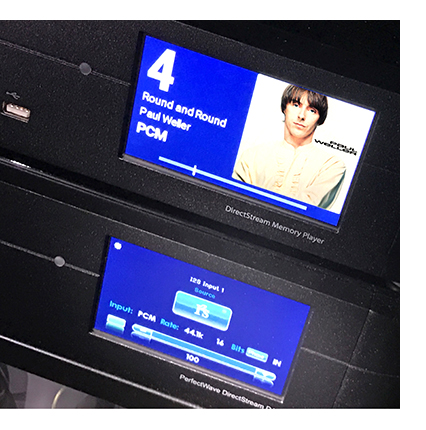 No matter what music you like the best, and what format, it’s easy to get lost in it with the DMP. If you have a spare internet connection for the transport as well as the DAC, the transport loads and displays the album art and metadata on the front panel screen. I like the extra user friendliness this provides, especially from across the room, or when a guest is over that isn’t always familiar with my musical taste.
No matter what music you like the best, and what format, it’s easy to get lost in it with the DMP. If you have a spare internet connection for the transport as well as the DAC, the transport loads and displays the album art and metadata on the front panel screen. I like the extra user friendliness this provides, especially from across the room, or when a guest is over that isn’t always familiar with my musical taste.
Rather than going into minute detail about this track or that track, suffice to say that everything is as it should be. Bass is detailed, powerful and defined. Highs are rendered effortlessly, without grain, yet full of extension. And the delicate midrange is lovely. Yet what makes this player so fantastic is the integration of all of it – I never found myself wanting more, nor did I ever (on even the longest listening sessions) start picking things apart. The homogenous manner by which the PS transport and DAC recompile digital music files is effortless in every way. I’m guessing you won’t need more than about three tracks to be convinced just how good they are.
More Stuff You Don’t Need
If you are a digital only audiophile/music lover, the high quality of the Direct Stream DAC’s digital volume control and line level circuitry is so good, you can skip the preamp, making this pair an even better value. With fully balanced circuitry and transformer coupled outputs, we had great luck using the DirectStream DAC in this mode with a wide range of power amplifiers. It drove 20-foot runs of balanced XLR and single ended RCA cables without a hitch.
Thanks to six digital inputs (coax, XLR, optical, USB and two I2S) the DirectStream DAC is the perfect digital hub. An additional $899 gets you PS Audio’s network bridge card, giving you Ethernet access as well. This allows your favorite UPNP or NAS to be connected and accessed directly. We can all log in to our favorite internet forum and argue about which offers the best sound, but I found the PS pair universally good, regardless of input. For those who love it, the PS combo is ROON ready, so you can have all that at your fingertips as well. This is a formidable combination.
Can You Tell, I Really Like the DMP
Cool as the extreme user friendliness of this pair of PS Audio components is, it’s the sound that sets this one apart from its comparably priced competitors. This is one of the world’s finest players at any price, and I’ve heard or owned most of them. There is a level of sheer refinement here that I guarantee will win you over.
Much as I love analog, and think streaming TIDAL is super cool, there are times that I don’t want to be a suspension mechanic or an IT guy. That’s when putting a shiny disc in the drawer and just pressing play is a lovely thing. Unless you’re going to drop six figures on a dCS Vivaldi or an Esoteric Grandioso, I can’t think of a better digital disc player than the PS Audio DirectStream Memory Player and DAC. (Neither of these six figure players will play your DVD-a discs) If I had more than two thumbs to raise I would offer them, it’s that good. The only remaining choice is whether you want silver or black.
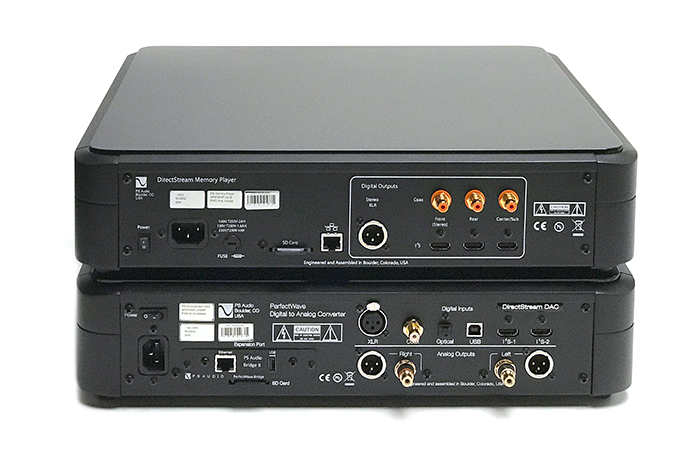 The PS Audio DirectStream Memory Player and DAC
The PS Audio DirectStream Memory Player and DAC
MSRP: $5,999 (ea.), Network Bridge – Additional $899
www.psaudio.com (main factory site)
Gotta have em right now?
To purchase the DAC, Click here: http://www.psaudio.com/products/directstream-dac/
To purchase the Transport, Click here: http://www.psaudio.com/products/directstream-memory-player/
Peripherals
Preamplifier Pass Labs XS Pre
Amplifier Pass Labs XS 300 monos
Speakers Focal Sopra no.3
Cable Cardas Clear and Tellurium Q Silver Diamond



